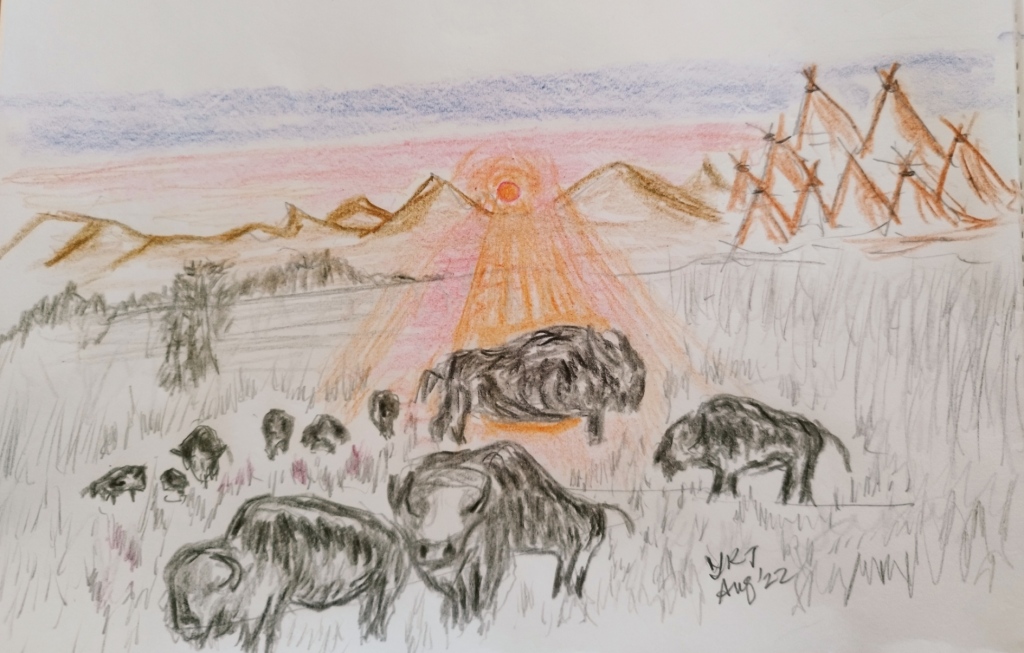The coyote bandits at Liberty Gate
There lies within the hearts of men and women a mean streak that must be suppressed – that of bullying those weaker than us or at the least, hold them in disdain. Why do I say this? Because warring nations in the past exerted themselves in subjugation of weaker nations, and behavior of such rogue national leaders are no different from behavior of individuals as they seek whoever to exploit. Look no further than the political adventurism of contentious countries today. What about animals? Do they bully?
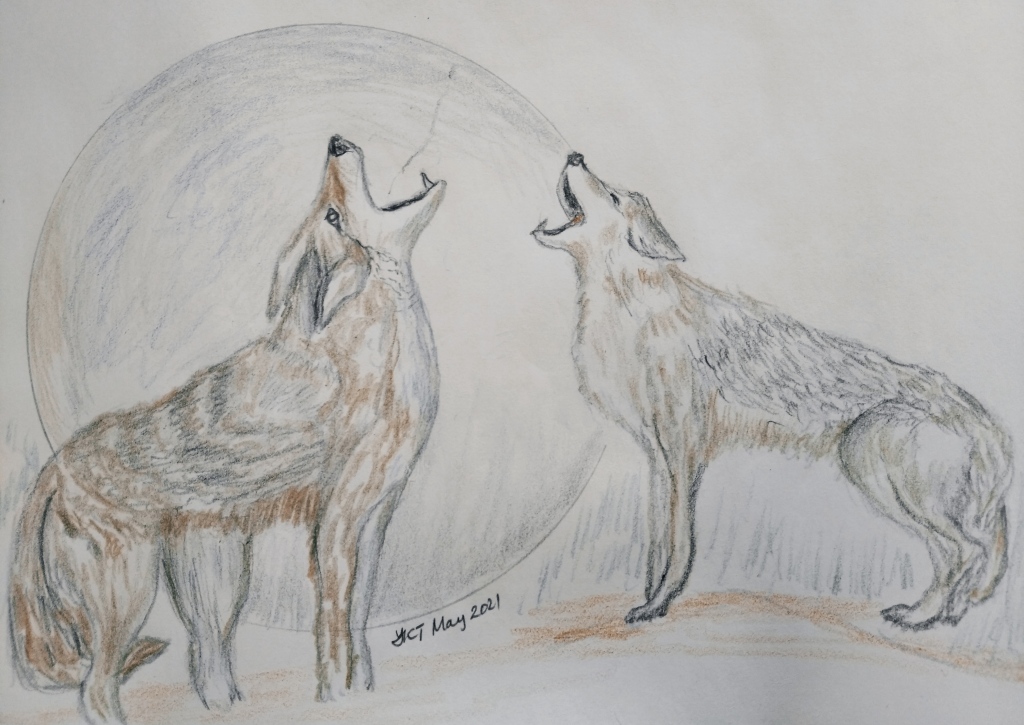
Far in the wild west of the Sahara Desert is a place called Liberty Gate. Within the compound is a mansion belonging to an animal lover. David Burns decided to plough his fortune to show kindness to whatever animals that come to his gate. The wild animals are free to come and go, and every time they would leave well fed, or carry some food back to their young or their herd. He started with a wounded lioness who could not hunt because of an injury or illness. Then apes or gorillas would come by in times of drought and David would share his crops from his well-tended fields. A lone bull elephant once wandered through his gate weakened by something wrong he ate had to be treated for digestive troubles and given antibiotics. He also kept livestock of chickens or small animals as offerings to emaciated refugee carnivores. David’s Foundation is also well supported the world over and not a few volunteers and veterinarians would help out in the animal halfway-house. This went on well for a year. Then word went round among the wild animals, or rather the smell of food went around.
The unusual event started when a young chimpanzee was set free after having its broken tail bandaged. The Liberty staff was generous enough to give it a bunch of green bananas as a parting gift. As it sauntered out the gate suddenly two large animals confronted it. They were African golden wolves – similar to the North American coyote (family canidae) but they were hungry and ferocious. They snarled and snapped at the diminutive chimp, causing it to drop his parting gift to escape with his bandaged tail. The bandits sniffed at the green bananas and took several bites at it. Then they abandoned it and slumped back to the shadow of the large gates to await better viands. Later they spotted another patient leaving the hospital. This time it was a young hyena, with a bandaged rear leg, torn as a result of a fight. Better still, in its mouth was half a chicken breast – a recuperation gift from Liberty. The wolves leapt into action – one standing in front and another snapping at the rear of the wounded hyena. It was no match. As it ran off tail between its hinds, the bandits started sparring over the dropped chicken – pulling it between themselves. Satisfied after consuming their booty they cowered back in the shadow of the gates, as if talking to themselves – “Hey this is not a bad idea – free food for the taking…” Then for several days nothing happened – none of the patients were going home. Even the gates were closed. Then on a rather hot day, suddenly the gates opened remotely. The wolves sat up suddenly, saliva dripping from hunger. When they looked earnestly past the driveway they saw a large object slowly approaching the gate. Eventually the animal came into view – a female elephant was slowly lumbering home – in her mouth she held a corm of ripe bananas. The bandits discreetly parted way for it to pass – maybe not today – they seem to mutter in their breath. They slumped away in the shadows panting in the heat, oblivious even to the couple of ripe bananas that dropped behind the lumbering gait of the elephant. They were famished for the next two days, drinking only from the meagre pond of stagnant water next to the road. Then it happened. A young bear trotted slowly out the gate – in its mouth was a large piece of venison. The wolves stood up, dribbling from the mouth with hunger. Rarely would wolves contest with a bear for food – but this time they outnumbered it two to one. The bear growled in anger when the two approached it, jaws slashing here and there. As it dropped its food, the bear stood up full height in defiance. The wolves momentarily cowered from the threatening stance. As one of them gingerly approached the dropped meat the bear swung his large paws and almost mauled the whimpering wolf. But no – just at that time the accomplice managed to sneak in from behind to grab the meat. Then the wolves retreated together – their prize safely in one’s jaws. The bear could only protest in loud growls, before disappearing into the woods. Then weeks passed – no patients to rob. The bandits were hungry and angry.
Then on a hazy Thanksgiving day they were in luck. With the setting sun, out of the gate strolled a Fennec fox, a sizable turkey leg in its mouth. Its back was bandaged due to a wound sustained by an arrow. As it walked nimbly forward the two monsters jumped in front of her – like nightmarish ghouls about to swallow it up. The fox calmly sidestepped the wolves and ran quickly to escape. But the monstrous wolves were fast and before long surrounded the fox front and rear. Helpless the fox yelped in anguish for losing its precious meal, dropped the turkey and trotted off. The bullies licked their licks and wolfed down the turkey meat, growling with insatiable estacy. “Did you see her?”, one wolf said to another. “Its like taking candy from a child!”. Just then two shots rang out in the falling darkness. The bandit wolves fell almost together, with bloodied wounds from their necks and head.
Up till today nobody saw, knew why or what actually happened. No witnesses. But for all the victims of the robbery at Liberty gate they knew one day justice would prevail.
Donkey Butterflies
Gandalf, the wizard in the book Hobbit has an unseen companion which appears only in distressed times of great danger and adversity. When he was about to plunge into the eternal depths a pair of butterflies appear, reassuring and comforting. Many of us face untold obstacles, whether a physical or mental debilitation, limiting our growth and progress through life. A character, Jabez in the biblical book of Chronicles, was said to have problems at birth and growth. He had to call upon God to bless him to keep him out of pain’s way and to extend his reach in life. There’s the creature today that can be a source of great reassurance and calmness – the unobtrusive butterfly.

Kissmo was only 2 months old when he was with his mother on work. Their master works at an apiary delivering honey to the market daily on the backs of donkeys. They had to trek through some valleys on the way, passing through patches of Malayan farmland and flower-fields. Kissmo was energetic, with no load on his back and wandered to the flowers, sniffing as he went like the scent of spring. But what fascinated him was not just the flowers. Butterflies of all shapes and colors would flutter over his head. Kissmo, enthralled would jumped at them hoping for a game of catch. But soon he tired, realizing that they were too quick for his tiny legs. Kissmo grew in strength while his parents aged to a point where they could not carry much of the weight of honey-filled canisters. So Kissmo began his duty of hauling honey. Such was his daily life – hauling honey on a pull-truck and taking breaks resting with his beauties on the hillslopes. Until one day an incident made him homeless. He was reaching the town where his load was to be offloaded when the cartwheel hid a large stone on the side. Suddenly the cart turned over, spilling honey over Kissmo’s back and canisters on the track. But what fell along the track was other stuff besides honey canisters. The local constabulary was at the scene and picked up what appeared to be sachets of some powder hidden between the canisters. Kissmo’s driver was taken to the local police station and the police sergeant confirmed that Kissmo’s owner was transporting banned drugs. Charged with contraband, the driver as well as Kissmo’s owner was arraigned and detained. With no one to claim ownership Kissmo was left to wander in the hills. He had no more than a hut for home as his owners were so impoverished that they had to turn to contraband to supplement sale of honey for survival. But Kissmo knew where the best grass were to feed himself – and where his favorite friends can be found.

Then his leisurely life wandering the hillslopes of Gunong Tahan took an interesting turn. That same afternoon of the cart accident the wandering Kissmo realized many butterflies of all shapes and colors flying about his rump. They were attracted to the honey than had spilled from the truck. He was delighted. But everywhere he went to look for his beautiful friends more and more butterflies gathered and landed on him, sucking up the honey from his back. Besides, bees also found the scent to gather around. Kissmo didn’t mind the curious daily attraction on his back but soon humans noticed it too. Some trekking tourists started taking photos and selfies with him and soon their postings on social media went virial, headlined “Curious butterfly donkey at Mount Tahan”. As weeks went by more and more international tourists saw Kissmo’s collection of butterflies. The Malaysian Tourist Promotion soon took notice. They found Kissmo a home and tended to his daily needs – feeding him supplements of food other than grass. He even appeared in a picture posting as an ambassador in the “Welcome to Malaysia” travel brochure. Who would have thought that such luck would follow Kissmo’s misfortune of loosing his job as a honey delivery donkey?
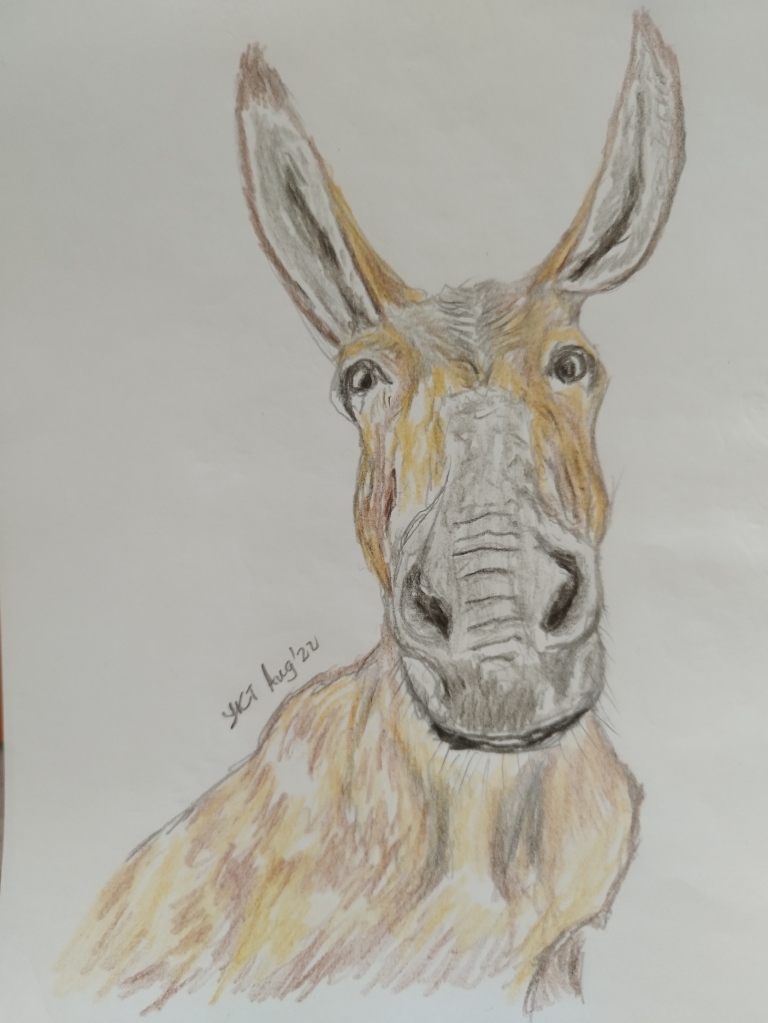
But Kissmo’s joy continued. One day out of nowhere a man came from behind and hugged him over his head. Overjoyed from seeing him again Kissmo couldn’t help braying that his Master was finally released from jail. But he could not find back his job at the apiary, being an ex-convict. So he volunteered to be Kissmo’s keeper in his tourist duties. He would try his best to explain the flowers and butterflies that encircled Kissmo whenever they meet them. Once, just to be an interesting guide, he tried singing for the visitors. To everybody’s surprise, Kissmo tried accompanying his master’s voice, grunting and braying as he sang. Soon the duo became a hit at the tours. “Come see the singing donkey and butterfly tours!”, the TV ad would appear. Who says anyone who’s a failure in life should be called a donkey?

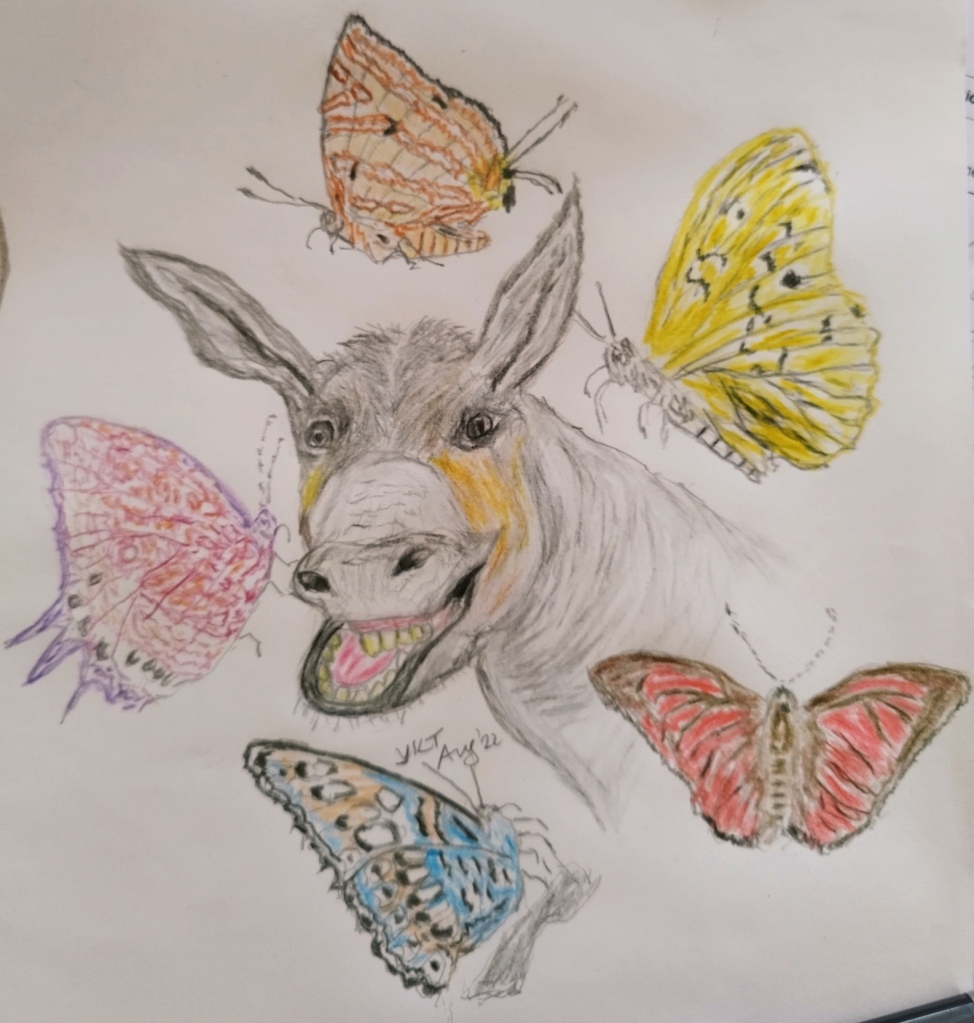
.
Cicada has spoken
Truth be told, there’re times I wish that I had kept insects than dogs for a pet. If they die I just throw them out where some bird will eat. They are great survivors if I forget to feed them. And when I felt like leaving the house, even for long trips, I don’t feel guilt of abandonment. But dogs show allegiance and responds to love. From birth puppies are programmed to bond with humans. That’s enough for some out of loneliness. The cicada however in their large numbers may have a purpose. They proclaim the significance of events to come. This is the story of Mamy and Ken – a couple that had a long time wanted a baby conceived of their own. They were well loved by their friends, family and community. Even the nation wanted people of their caliber to produce children, believing that well-endowed parents provide the hope of future generations to ensure the country’s future. Despite all the public hype and financial windfall, the prospect of the couple’s natural off-spring was as bleak as ever. And even bleaker as they grew older. But they became busier with age, because their background, training and performance drove them to even greater responsibilities. And even lesser time for family-creation. Then when she passed her late forties, Mamy had already given up, with more time for even greater professional pursuits, foregoing the psychological burdens from expectant parents. What about Ken? He’s no less illustrious in his career but the tensions from a deficient family life at retirement was starting to creep up upon him. As they say, a man is always ready to start a family and a successful man with all his fortune makes a prime candidate to do so. But human relations are more complicated – both Ken and Mamy were hopelessly dedicated and true to each other. There was a similar story of this in the biblical character of Abraham and Sarah. Sarah was barren into her eighties and yet Abraham believed Sarah would be the source of the God-promised son. Then in a moment of madness, Sarah suggested Abraham take on a mistress to fulfil that role, which he duly complied. And probably instantly regretted. For Ken there was no such cure. He loved Mamy until the day of her death and even after. Still he remained the most eligible widower in the universe, or so he thought. And perhaps the most desirable. But no, there’s no break from the past and a life of loneliness was part self-imposed. Until a veterinarian friend suggested adopting somebody’s unplanned puppy.
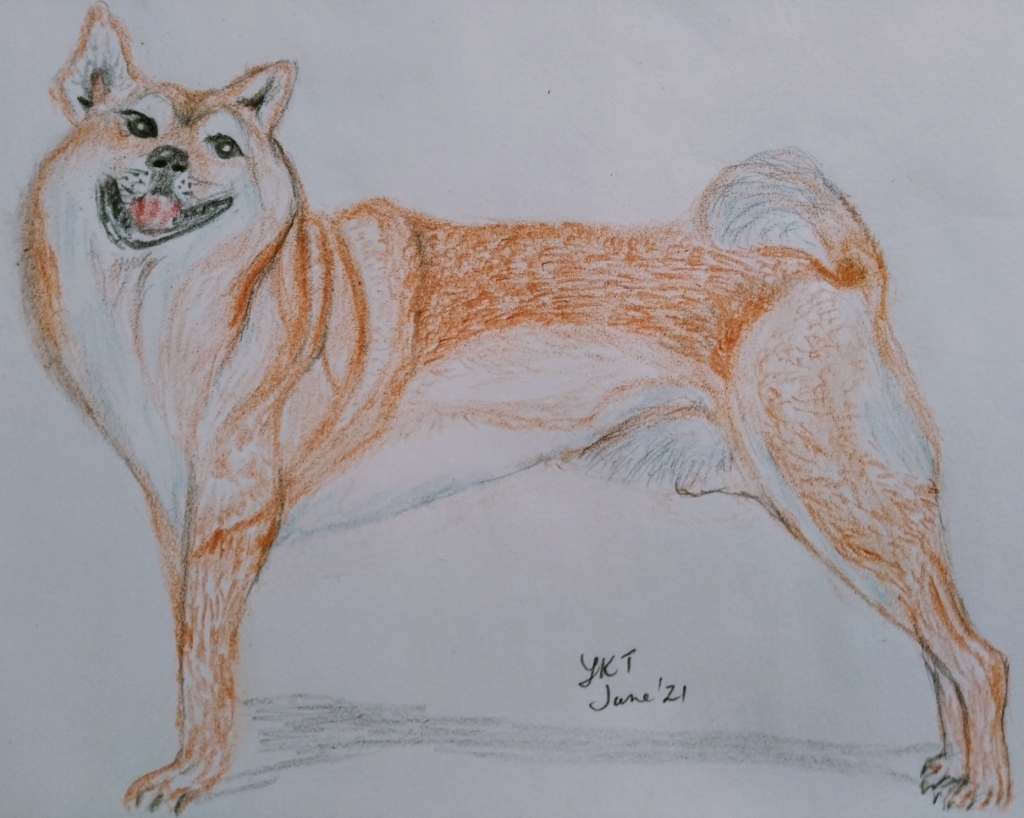
Man and dog became inseparable, like a lost love transferred. Ken’s loneliness seems cured – temporarily. As the beloved puppy aged frequent visits to the vet became necessary for the besotted owner, hoping to have the companionship for life. It was not to be. At the last visit to the vet, even she could not help feeling sorry. Ken became alone, crushed again by separations that wrecked his life. After his first dog died Ken continued to visit the vet looking at possible re-adoption. But he couldn’t bring himself to outliving the wonderful pets even shelter dogs provide. Then a friendship blossomed – with the vet. Those daily visits for the puppy and adoptions had finally taken their toll. Who would have known that that became the Sarah cure? Anyway Ken finally did not have to be alone the rest of his life, plus the pleasure of a body and soulmate missing for a decade. Yet the memory of his first love stayed unsettled and the romance did not end in thoughts of marriage. In fact it did not end anywhere. Until…
One rainy day Ken’s vet lover announced the prospect of a new arrival. Ken was esthetic. Finally a complete family! He was so joyful with the fulfillment at such an advanced age that he couldn’t sleep that night. Trashing about on his bed he thought he heard a strange sound outside on the still night, after the rain. When he opened the window the sound was deafening. It was the buzz of cicadas, thousands of them, enough to cause deafness. Like mayflies they have this divine plan of survival of the specie. The force of procreation is so great that millions of them would mature about the same time furiously looking for mates to ensure satisfied union and reproduction. Turns out that the new baby is not his. And the truth would not be revealed by her, even if he cares to find out. The cicadas have spoken. Even with the truth out they would remain intimate friends – he’d care for her baby and she his dogs. Quit pro quo.

The cicada spelled a life change on his love-life
When a serow meets a stoat – how the dancing stopped
It has been said that thunder never strike the same tree twice. Unless the mind plays tricks on you with dejavu, many will confess that apparent coincidences can happen multiple times.
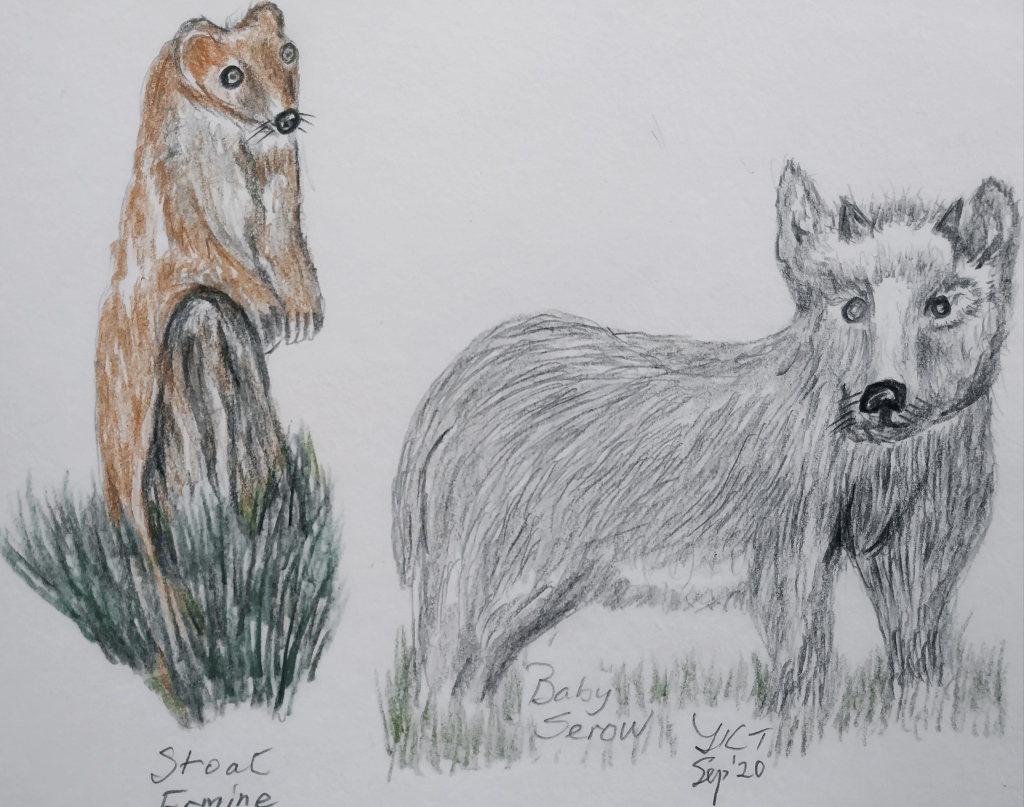
Seve, a serow native to Japan lives in the woods of Hokkaido. They are like mountain goats, feeding on grass and tree barks in winter with the demon-like little horns on their heads. One winter while stripping out what nutrition he could find on japonica shrub he thought he heard a rustle nearby. Looking up there was a stoat (mustela erminea orientalis) with its long neck peeping out from a slender rock. Stoats or ermines are related to the weasel family and the species native to Hokkaido usually sports a white coat of fur. This one had shades of brown – with its paws hanging down it seemed Seve had found a willing friend. So they forage food together although ermines are carnivores, hunting small animals. That evening Seve had a dream.
He was a stone – a small one like the millions of stones scattered around the hillside. Being one of the millions around he was totally helpless – stones will roll whenever there is a lower level available. Not only that – whenever there is an injustice around stones remain passive, unable to protest or champion themselves to a cause. Seve was perplexed so he turned to his friend. The stoat had a simple answer – creation must wait for the Creator for justice. But meanwhile all will have to live within their means. Seve was somewhat unsure but the two ploughed on. Their search for food in the wintry months led them to the riversides to look for surviving shrubs and perhaps fish or turtles for the stoat. They stayed there past spring. When the heat of summer arrived it became easier for finding food as the river came to life. One sunny evening the water was calm and mist started rising from the surface from the noonday heat. Seve stood for a moment staring across the riverbank. Then they appeared – only a few at a time – rising from the river surface and fluttering around. Mayflies. As if on cue groups of them starting appearing together like tiny helicopters struggling out of the river depths. And on and on they grew in numbers. You could hear the fluttering of their tiny wings as millions of them came across like the roar of a typhoon wind. Then suddenly the cloud of flyers collapsed together onto the water surface. But only momentarily. Again from the collapsed sheets of wriggling insects emerged some taking off from the water and rising high above the river. Then came the predators. On the river a splash broke out on the surface as fish jumped on the hapless male mayflies fulfilling their last rites of copulation. Birds swept around and snatched the females, loaded with eggs, in midair. But their sheer numbers would not be consumed completely. Scores rose higher than the overhanging branches and disappeared into the foliage, carrying their fertilized cargoes into the future. Seve and his friend turned to go – just another mystery of life. But the story repeats itself since creation for all living things:
Swarms of females at some time of their lives would seek to be mated. Their sexual fulfilment with males driven to copulation completes a death-like mission with the force of progeny. Surely this must justify that all living things, male or female must eventually march to the end of their lives.
One day the stoat said to Seve – “Let me show you a place where we can hunt many fowl”. He led the Seve through many strange forest paths and came to a riverside. In the darkness they came on a scene of many water fowls moving together.

Flamingoes breed in large numbers near where bountiful crustaceans and small riverbed fish lives. But they are constantly moving – as if in a group dance. It is just a survival tactic. By constantly moving about their predators would have trouble focusing on a single individual as prey. Watching them you would have thought they were doing a dance – the likes of a samba or mamba – moving their heads here and there and kicking their legs in a confusion of moves. The stoat and Seve approached slowly, ready to pounce. But as soon as their feet hit the water’s edge the entire herd flew – taking off in droves. Well we tried, said Seve, turning round to look for easier food like the shoots growing at the riverside. But the stoat persisted. He slowly approached the flock further up the bank, hoping to snatch a young unsuspecting chick. Then just before he rush forward came a sound of rushing wind. From the sky an eagle swopped toward the flock.
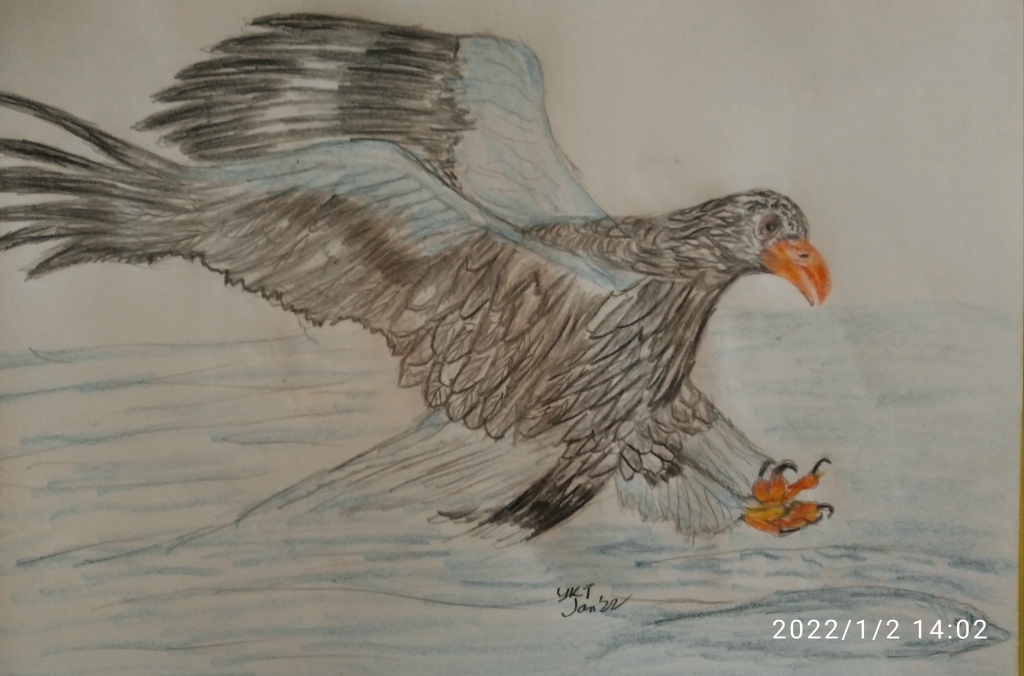
Again the dancing troupe scattered, splashing water around. The stoat ran back toward Seve, who was already in the forest shade. The dancing stopped and a calm fell onto the sunset.

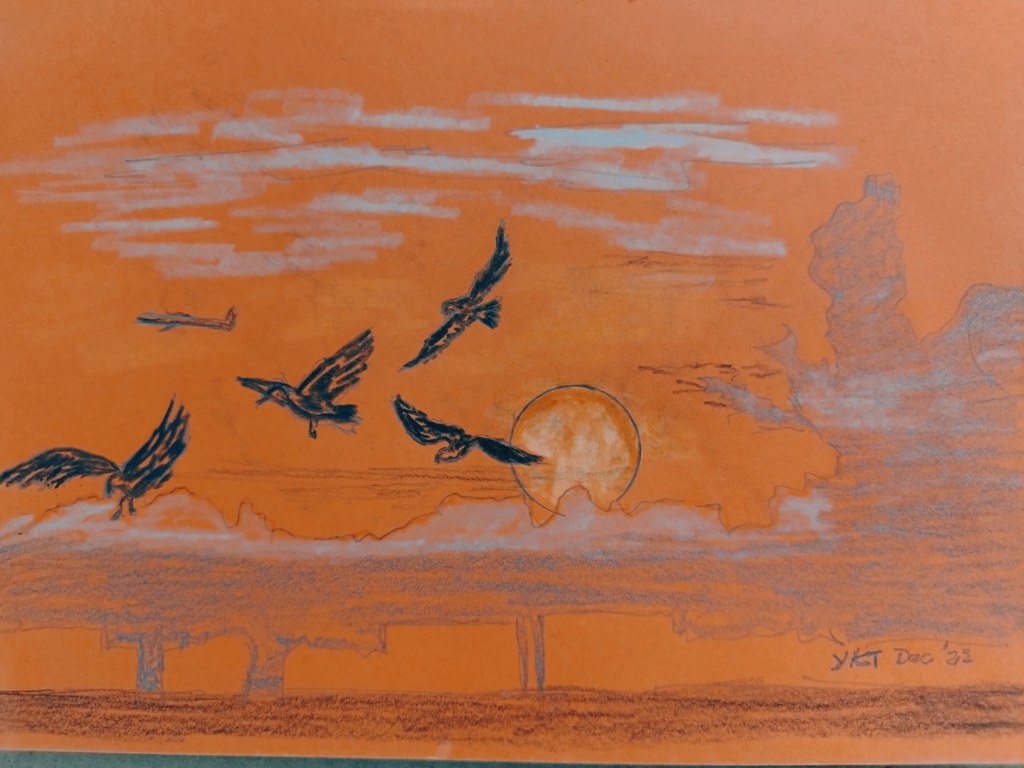
The curse of anonymity
Snakes are not all bad. If you’d stopped in your tracks on hearing this perhaps you might not know that only about 600 of the 3000 species of snakes are venomous (to humans) and you may have to look for them. Then there’s their movement. Hearsay conditions us to think that all silent attacks are stealthy. Not with a rattlesnake – it’s warning rattle is perhaps to not waste their venom on a human-being. But true to form few people like slithering, crawly creatures and snakes do not demonstrate polite dining manners – most swallow their meals whole and to do that for large fares they have a jaw-dropping habit.
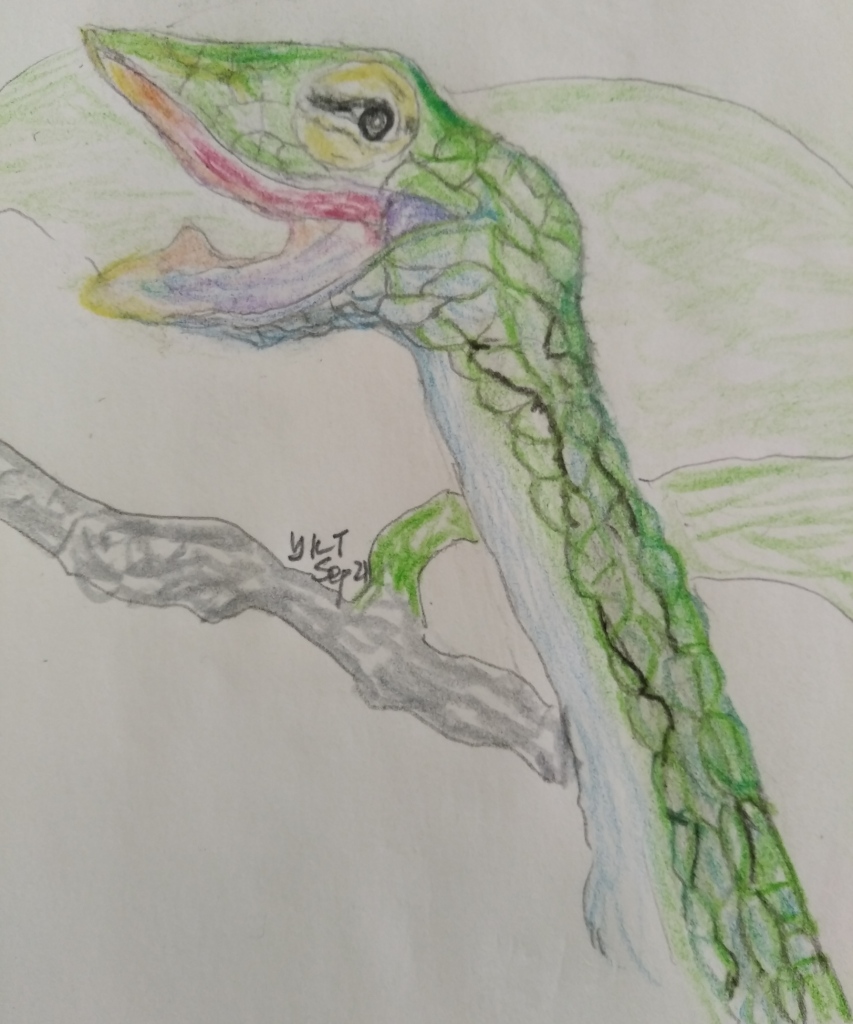
Our story concerns the bigeye whip snake – one that might pop up in your garden bush occasionally. It did so at Mrs Damselsmith’s rose garden. Her husband is an avid composer and would be at his piano most of the day, letting out his music through the open window to the garden. He had been doing it for years, but fame eluded him all the time as none of his compositions hit the right note for excellence and celebrity. Sometimes he would play his favorite pieces thru the sound system while accompanying on his piano. One day his repertoire of dance music was particularly lyrical and lilting that he did not realize someone was enjoying his music. On the rose bush was Snipes. One look at him would make you laugh – the bigeye whipsnake had this comical look about it – as if it was enjoying some kind of joke all day. But Snipes is special – he loves to dance. And the dance music that day was particularly infectious. Swaying slowly this way and that he followed the rhythm wafting out of the window. It came to pass one day the composer was seriously writing out a new piece – a samba dance. But Snipes had a problem – there was another snake which visits the garden – a cobra whose appetite favors other snakes. One day a terrifying thing happened. The weather was fine and the gardener was out weeding and trimming the bush. Mrs. Damselsmith was collecting flowers for the dining room when she noticed Snipes – shaking away and turning its head here and there to the music’s beat. So charming, she said to herself and went towards a tree to pick some apples for the living room. Little did Snipes knew that he was being stalked. Then abruptly the music stopped. When she turned back she let our a muffled grasp. On the grass was the cobra wriggling, its head missing. Seems that the gardener did not notice and accidentally snipped off its head when it was about to strike Snipes. It was easy to do so because the color of the cobra matches the brown dead leaves of the bush. The gardener came near, shaking his head to his mistress and apologetically collected the dead cobra in a bag for disposal. The composer poked his head out the window with a puzzled look. Mrs Damselsmith turned to her husband to explain the commotion. “Funny…”, he replied – “when the gardener snipped its head my mind went blank and I couldn’t continue at all on the piano!” But Snipes was alive – hidden deep within the bush, waiting for the music to come out. When the composer resumed his recital Mrs Damelsmith saw Snipes at the top of the bush. “What a likeable fellow!”, she said. “Would you like to come hunt some of those pesky lizards in my house?” So the gardener put Snipes in a chicken-gauze cage and transferred him to a corner of the house in the porch where lizards abound. Snipes was given free-rein on a bush planted beside the corner and from where he could go in and out to the garden. Once in a while he would crawl up the tall bush, which reaches almost to the ceiling, stretch out his head and pick off the lizards that feed on the moths swarming around the lamp. That’s not all – Mrs DamselSmith got the electrician to run a loudspeaker that pipes her husband’s piano music for Snipe’s enjoyment. Visitors to the house at dinner would look curiously out to the corner, enjoying not just the Master’s dance pieces on the piano but the sinuous twisting of the house entertainer, which in a moment of joy would give the visitors a happy-snake look. Finally the composer had found fame – in the form of a dancing snake.
The king that learned to swim
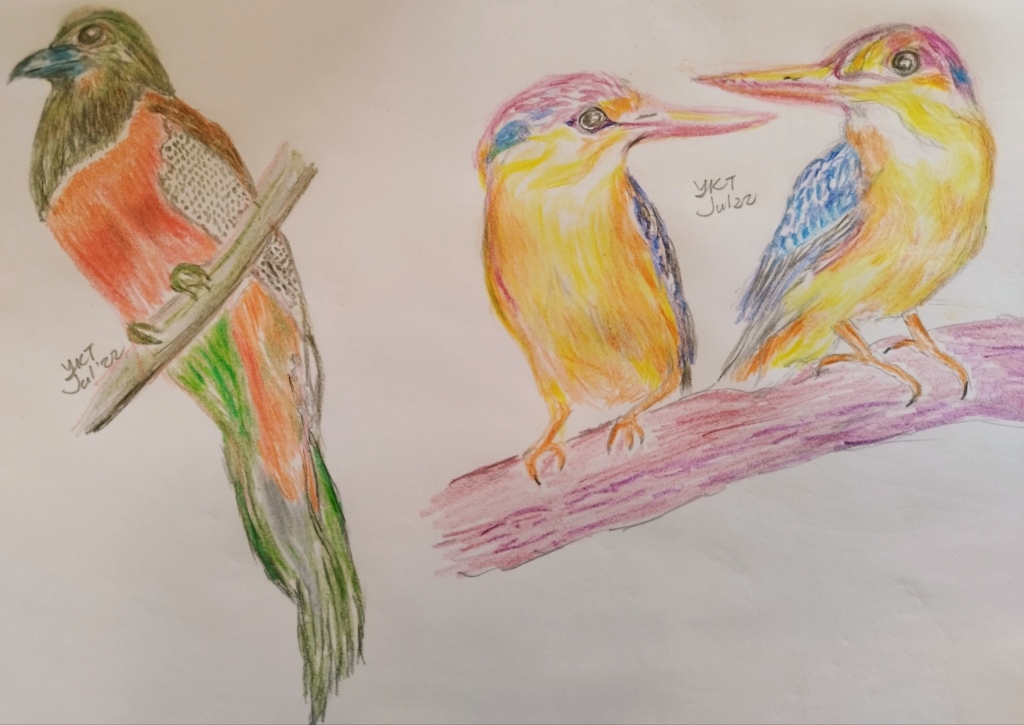
There are dozens of birds that can swim. Those that stay for long in or underwater are water-birds like ducks, geese, swan, penguins, puffins, cormorants, loons or grebes. Birds however that dive underwater momentarily to hunt are different – they do not have the breathing mechanisms to live comfortably under the water surface. This is the story of the oriental dwarf kingfisher Jarro. Jarro likes to sing and sometimes you can hear him in his signature cries ringing through the forest. But he can’t stay that way for long – hunger pangs drive him to hunt. He would stand silent on a riverside branch for a while choosing his target and dives in for a kill. Often he would catch small fish that came to the riverside. One day the fish in view was larger – and quicker. Jarro dived – but missed. The fish returned and Jarro missed again. I need to pursue it underwater, Jarro thought to himself. So when bigger and faster fish come alongside Jarro would pursue for a longer time underwater. Soon he began to last longer underwater. Jarro was happy that he did not have to make those repeated dives he did before – larger fish he caught lasted longer before he needed to hunt again. Until one day a sea-eagle came to visit. Jarro was singing on a branch and his repertoire attracted the predator. Swiftly the eagle circled down towards Jarro – a kingfisher would do if there are no fish around for lunch. “Dive Jarro! dive!”, Jaro’s friends seem to scream from a nearby bush. Jarro jumped – just escaping the eagle’s talons. Then the pursuit. Jarro dived into the water. The eagle was stunned for a moment. Never before it had to catch his prey going into the water surface – mostly all it needed was to lift a swimming fish out from under the water. It circled away from the water surface, its talons swung aimlessly. Jarro emerged on some rocks at the shore. The eagle spotted him and swung into action. Jarro dived again into the water. The eagle followed then dived towards the water surface its talons swinging slowly like a pendulum would. As Jarro emerged again in the opposite bank, he saw the eagle flying off, a large fish caught within one of its leg’s talons. Crap! – that was my lunch – Jarro swore within his breath. But it was a close escape.
Then another day it happened again. Jarro was catching a fish underwater when he sensed a commotion coming from above. As he landed on his favorite branch he saw them.

They were frolicking around having ran in from the seaside some distance away. Jarro dived again for a second catch and soon he sensed a disturbance in the water. Two otters had entered the river too and swimming strongly towards him. Not again! Jarro abandoned his target and turned away from the invaders hot in pursuit. Jarro had no match in speed-swimming like he had against the eagle. “Fly-up! Fly-up”, he heard himself shouting. He flapped his wings to leave the water and this time the otters were stunned. As he landed on his branch, empty-handed Jarro looked in anger at the splashing from below him. The otters had began to clean up his fishing grounds. Time to look for another river he thought. What’s a king without a kingdom?
The elephant with no name
His was a cheerful birth. At that time both mother and the bull were so happy to welcome him into the world. And already he had two other siblings – running and splashing around the lush lakeside. An elephant’s birth can be quite a splash. Mother would cradle him with her trunk near the sac and pushed his relatively tiny legs to walk pass the amniotic fluid. And dad – what a delighted father. He would often lie down to within his reach and allow the wriggly pachyderm to crawl all over his massive hide. So the baby grew – in size and curiosity. Every individual in the herd was his play-fellow.

You would wish baby elephants are forever. But he grew up, at a time when the elephant camp in the Thai resort needed help in reconstruction for the growing tourist industry. So the keepers came and took him away from the herd to train as a logger. Normally an elephant takes 16 years to be weaned from its parents and the first 2 years of its life is fragile – it is said that more than 30% of calves in the wild do not survive. Anyway at 5 years old Sottai was given a name. So started his variegated life. Though stressed when separated from his playfellows Sottai became a sturdy worker – and sometimes tourists would come by and pat his hairy hide – still not enough compared to the love received from his herd. For 16 years he had to work between dragging large logs or impress humans and their children who had never seen a live elephant up close. Still he was never far from the chains that enslaved him. What happened to the cheerful and playful side nature endowed him with? He would say to himself – the harder my fortunes the stronger and kinder I would become. But his hard early life was not entirely sterling. One day he refused to drag the chains anymore – regardless of the pain from the goads. Then under labor he let out loud cries of anguish trumpeting through the forest and unsettling visitors and other elephants. Yet heaven did gave him a kind respite. His mahout was a kindly old Thai, who felt sorry for him and intervened to have him learn painting and entertain tourists. Elephants are amazing creatures for their trunks. A human being has 600 muscles in our body – an elephant has 40 000 in the trunk alone. Still he was en-chained like all the other working elephants, and of course they are not born artists. After a coupled of years he could hold his own palette and made some repeated strokes that delighted the crowds. He was given another name and earned his keep for a year. Then the pandemic struck and tourists dried up. He was alone again. And unemployed. By now Sitchai, a name more suited to being an artist is a full grown male, and restless for a mate.
He found his comfort in an older female. She actually worked longer dragging logs than him but because of her size she was given lighter loads. Still, at the end of the day Sitchai would lumber up to her in their enclosure and found relief and friendship. Elephants have a distinct way of bonding. Their trunks would constantly be probing and caressing and they would even look each other in the eye. As the pandemic dragged on for another year the resort owners decided that maybe the pair can join the circus – traveling to audiences than having them come to the resort. Sitchai was trained again for circus acts. In the old days cruel things were done to animals for circus but Sitchai took it in his strides. But still if you are hardworking and earnest in this world you may still be abused and bullied. Sitchai and his female companion had to endure the unnatural way circus elephants were made to march and walk – on hind legs and on balancing balls. Elephants are very sensitive to the surroundings and to the living things they interact with. Sotchai (that’s his new name given by the trainer) reacts very differently to his care-taker and the trainer. Sometimes he would scream with joy at the end of the day on meeting the one who feeds him and prepared him for performances. But at the sight of the trainer he’d often look away or flaps his ears in disgust. Then after a few months into the pandemic his destiny changed again – this time instead of being kept it was decided it would be less costly to release him into the jungle and training him to fend for himself. It was a tough call again – Sotchai had not been with a herd for over a decade – how’s he going to learn to live in the wild? His female friend was also released, but in a different part of the country. Sotchai was crushed – he had to be – elephants remember everything. So he was wandering in the jungle – a few weeks he was followed by a mahout for safety. It was a mixed fortune for him – gone are the chains but where is the daily feed of unsold bananas and fruits? Then another respite from heaven.

One evening he was approaching a waterhole deep in the jungle he met several individuals – a herd with a familiar smell. After a few moments of standoffish silence and trunk waving it dawned on him that he had found his long-lost family. His siblings had all grown up with their own calves. More trunk sniffing and ear-waving, then cries of joy ensued. Sotchai (or whatever humans called him) was home. No more chains and slavish human oppressions. He was free to be a pachyderm again. As the sun set that day its crimson rays fell on the herd heading into the jungle – a herd that had the healing of a lost son. But it wasn’t the last healing from the affliction of humans. Several weeks later he met her.
They were in the jungle. There was a familiar scent again – the scent of a woman. Then moving into a small clearing he saw her – the old log-dragging friend that suffered so much with him. But she was lying down on her side, her trunk turning here and there. He approached – tears oozing from his weary, crinkled eyes. She didn’t even lift her head or tried to get up. He crouched down wrapping his worn trunk around her head again and again, stopping here and there to sniff out his beloved fellow-sufferer. He let out a soft rumble from deep in his throat. Her trunk now turning in smaller circles as her body, wasted from years of labor and abuse began to cool down. When the tip of her trunk could barely quiver he got up and slowly turned to rejoin his herd. He knew that was the moment.

Welcome to my parlor
There are over 5000 species of ladybird (coccinellidae or ladybug) having various colors to their wings. Florists will tell you of how useful are they in keeping out harmful insects from plants – in particular aphids which suck out the juices of their host. The ladybugs would gobble them and quickly fly to another leaf or plant to keep out the almost invisible pests. The 7-spotted red and black ladybug is most seen and loved in N America. Their colors are a defense mechanism – warning predators of the repulsive secretion from their joints when attacked.

Her name is Borela and she’s a 7-spotted lady. Sometimes Borela would meet many of her friends – all with different colors on their favorite hibiscus branch. There they will clean up the aphids around the yellow flowers and find a nice cool spot to lay eggs.
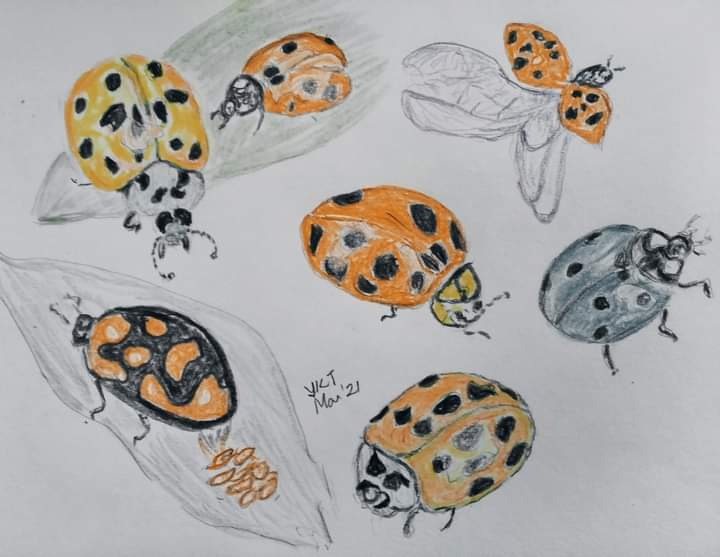
One day while they were scuttling under a leaf to deposit their eggs all of a sudden a shadow jumped in front of her.

It was a jumping spider. (telemonia) And it cornered them into his lair by waving its long, hairy legs. With a booming voice and a sneaky laugh he proclaimed – “Welcome to my parlor!” Borela turned to her friends saying, “That sounds familiar, wonder where is that from?” “Enough!”, said the spider, “today we will have a conference of colors since all of you have decided to come together in one place.” “Nay”, said Corela the yellow-polka dot, “You have no web to ensnare us, so all at once we’ll stretch our wings to fly off.” As Borela stretched out her wings the spider jumped so that she had to move off to avoid his landing. “Fools! Don’t you know that we salticids don’t make threads but kill our preys by ambush?” But before he could pounce again, the entire colony of ladybugs stretched their wings and disappeared in an instance. Those idiots don’t know that socializing is, he thought to himself and crawled clumsily under another leaf to hide for another ambush. But not long afterwards the entire branch shook violently. The spider poked out its head and saw a yellow flash of color. It was a black-naped oriole, looking here and there surveying for insects.
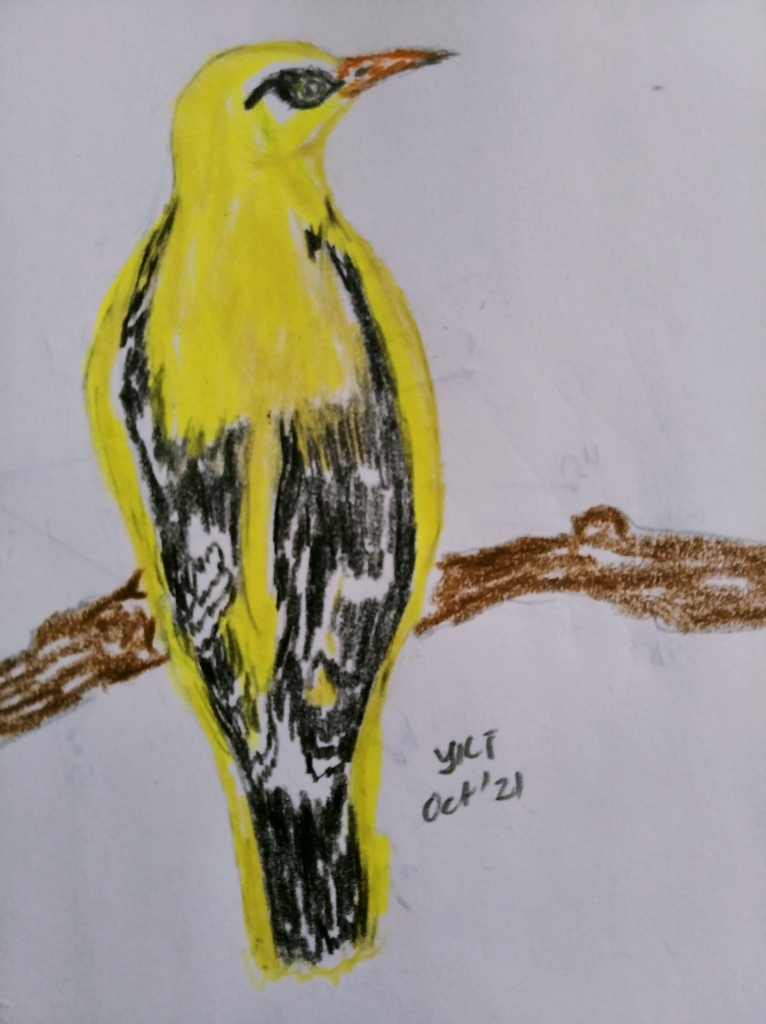
Oh, oh – the spider now turned its head back – time to go, he thought. But the oriole already sensed its presence and flew instantly to peck under the leaf. The spider jumped again – into nowhere out of the tree. He got lucky, landing onto another leaf with three ladybugs. But this time the colony stood still and in unison oozed the repulsive smell of secretions from their joints.

The spider turned and scuttled clumsily down the underside of another leaf.
The magic arrow

The North American bison (species bovini) or buffalo is thought to migrate to the continent from 195 to 135 thousand years ago. It was estimated to number 60 million in the late 18th century but dropped critically to 581 by 1889, due to commercial slaughter and diseases brought on by domestic imported cattle. Recovery efforts in the mid-20th century then brought the numbers up to about 30 000 wild bison in 2019. However the genetic bottleneck remains a problem due to a lack of genetic diversity in its propagation. Native Americans had spiritual and cultural connection to the animal and today is the national mammal of USA.
In the early 17th century the Arapaho Indians routinely hunted a bison herd in the lowlands of the Tetons. One chieftain whose Indian name translates to “Broken Tooth” had to worry not only about meat but rain for the crops which the tribe ate with bison. One summer the rains were very late and despite all the medicine man’s machinations the crops were drying up quickly and the squaws had to walk miles to fetch drinking water. In desperation Tooth angrily pulled out an arrow from his quiver, stretched his bow to the limit and shot it straight up into the sky. Cowering in fear lest he had angered the thunder god, Tooth ran into his tepee to await his punishment. Sure, the thunder god must have been angry for a loud thunder ensued with streaks of lightning slowly building up on the mountainsides. To his amazement, several moments later sheets of rain began to fall. The rest of the tribe was ecstatic, some breaking into dance with spear, war-bonnets and other ceremonial head-dress. Tooth was partly amused, wondering if he had done the right thing, when a boy came to his side. In his hand he had retrieved the arrow that had brought the rain. Casually, he threw it in his tepee and joined the dancing throng. Months passed. But the drought in the following summer was far worse. The elders in the tribe was restless again and turning to Tooth for relief. Tooth was crestfallen. Then he remembered the arrow incident. He pulled out the arrows from his quiver and shot them in quick succession as high as he could into the blazing sun. Nothing happened. Then he asked his other chiefs for their quivers. Soon all the arrows were spent but the sun kept its blazing heat on the fields and tribe. As evening fell, Tooth retreated to his tepee in frustration, hot in anger. As he lay his head back he saw the arrow lying in the corner. He had forgotten about it. Wondering if he should even try, he raised himself wearily and grabbed the bow on the way out to the starry sky. Slowly he drew the bow. He didn’t even pull it to the maximum when he released. Soon storm clouds gathered in the sunset. A while later lightning and sounds of thunder gradually rolled in from the east. Shrieks of joy and loud chanting arose from his tribe. Again Tooth felt relieved. When the dancing was over he ordered his tribesmen to gather and find the arrow. Which one? Hundreds were shot into the sky earlier. In exasperation he turned to the boy. And he instantly recognized the magic arrow – the one with a reddish bloodstain on its fletching.
And so the Arapaho tribe had no drought problems for several summers and word got around to other neighboring tribes to have Broken Tooth help bring rain. Tooth took special care to ensure the magic arrow was found at each shoot and he kept it in a separate slot in his quiver. Until one autumn hunting season. He hadn’t used the magic arrow for a long time for the rains had been timely. Together with his hunting party they came upon a stout bison. He was bravely protective of his cows and calves. The native Indians needed to kill only one beast to have enough meat for a season. But Bravo the stout bison would protect by coming between the hunters and the chosen calf. All the arrows that missed their target was shielded off by Bravo. Broken Tooth had almost used up his quiver and it would take many strikes to take down a bull instead of a calf. In the heat of the moment Broken Tooth fired off his magic arrow at Bravo. It found its mark at Bravo’s hump. With a painful groan Bravo ran off back to its herd, several arrows embedded on his back. When Broken Tooth returned to his tribe with the vanquished calf he discovered with great sorrow that his magic arrow was now roaming the mountains with Bravo instead of bringing rain to his crops. Word began to go around to his tribesmen and other tribes to look for Bravo and the magic arrow. Meanwhile Bravo began to experience the magic of the arrow, still stuck fast to his hide. Bravo, still very much alive with the superficial wounds on his thick hide would go around with his herd looking for greener pastures and for waterholes. But one time when they ran out of edible greens, and encountered dried out waterholes, Bravo shook his shaggy back and a thundery shower would follow. Bravo soon learned that by as much as shaking the magic arrow on his back, rain would come. However one day a hunting party spotted Bravo with his signature clutch of arrows stuck on the center of his humped back. The attack was furious – retrieve the magic arrow by any means. Bravo ran for his life. Through tall bushes and overhanging branches he gave up all the life that remained in him. Suddenly the pursuers stopped and backed off the chase. He was spared only when the pursuers noticed all the arrows that stuck to his back had come off. Bravo limped back to his waiting herd and the group of hunters starting searching the brushes and the trees for that one arrow.
When Broken Tooth got back his arrow he was delirious. He brushed off the blood and dust and waited for the moment to test its power again. But no rain came – not even any signs of thunder or lightning. He tried again and again, pulling so hard to the breaking point of his bow. Nothing. The arrow was magic no more. Somehow Bravo’s blood had tarnished that blood on its feather that gave it its magic.
